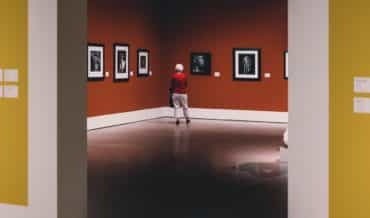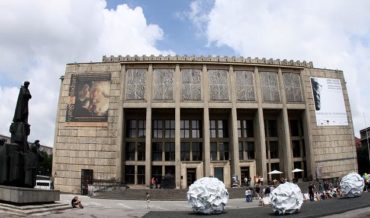Contents
Key Facts
• Born in Lviv in 1823, died in Kraków in 1894 – lived for 71 years during Poland's partition period
• Dual education – graduated in law from the University of Vienna and studied painting concurrently
• International artistic formation – trained in Paris and Venice, absorbing French academic traditions and Italian Renaissance techniques
• Cultural institution builder – president of the Society of Friends of Fine Arts, co-founder of the National Museum in Kraków
• Academic leadership – professor and rector of the Jan Matejko Academy of Fine Arts in Kraków
• Portraiture excellence – recognized as one of Poland's finest portrait painters of the 19th century
• Historical painter – created significant works including "Envoys to Sobieski" and "The Chicken War"
Early Life and Formative Education
Henryk Rodakowski was born in 1823 in Lviv (then Lemberg in the Austrian Empire), into a period of profound political upheaval following Poland's partitions among Prussia, Austria, and Russia. His family background provided him with access to higher education, leading him to pursue legal studies at the University of Vienna while simultaneously undertaking formal artistic training.
Vienna during the 1840s served as a crucial cultural crossroads, where Rodakowski encountered the academic painting traditions that dominated European art. His legal education, while seemingly unrelated to his artistic career, likely contributed to his later organizational skills and meticulous approach to composition. This dual educational path reflected the pragmatic choices of Polish intellectuals who needed diverse qualifications to navigate the restrictive political environment of partitioned Poland.
The combination of juridical training and artistic study gave Rodakowski a unique perspective that would later manifest in his methodical approach to both artistic creation and cultural institution building.
European Artistic Formation
Beginning in 1846, Rodakowski undertook an extensive artistic pilgrimage across Europe's major cultural centers. His residency in Paris proved particularly transformative, as the French capital dominated European artistic discourse during the mid-19th century. There, he absorbed the influence of French academic masters such as Jean-Auguste-Dominique Ingres, whose precise linear style and psychological penetration would echo in Rodakowski's mature portraiture.
His subsequent period in Venice provided direct encounter with Renaissance masterpieces, particularly the Venetian colorito tradition exemplified by Titian and Veronese. This Italian influence is evident in his sophisticated handling of color harmonies and atmospheric effects in later works.
The artist's returns to Lviv and Stanisławów (modern-day Ivano-Frankivsk) maintained his connection to Polish cultural themes and provided access to the subjects who would populate his most significant historical compositions.
Leadership in Polish Cultural Institutions
Society of Friends of Fine Arts
As president of the Society of Friends of Fine Arts, Rodakowski occupied a pivotal position in Polish cultural resistance during the Austrian partition. This organization functioned as more than an artistic society—it served as a vehicle for maintaining Polish cultural identity when political expression was severely constrained. Under his leadership, the Society organized exhibitions, supported emerging Polish artists, and fostered networks that sustained national artistic traditions.
National Museum in Kraków
Rodakowski's role as co-founder of the National Museum in Kraków represented a strategic effort to preserve Polish cultural patrimony during political subjugation. Established in 1879, the museum served as a repository for Polish artistic heritage while asserting cultural continuity despite political fragmentation. His involvement in its creation demonstrated his understanding that cultural institutions were essential bulwarks of national identity.
Academic Excellence at the Jan Matejko Academy
His appointment as both professor and rector of the Jan Matejko Academy of Fine Arts in Kraków crowned his institutional career. The academy was named after Jan Matejko, another towering figure of Polish art, reflecting the prestigious artistic tradition Rodakowski helped perpetuate. In these positions, he was instrumental in:
- Developing pedagogical approaches that synthesized European technical standards with Polish thematic content
- Training a generation of artists who would become leading figures in Polish art, including several who would achieve international recognition
- Establishing curricular frameworks that balanced academic rigor with national cultural priorities
Artistic Achievement and Stylistic Analysis
Historical Compositions
Rodakowski's history paintings exemplified the 19th-century Polish artistic preoccupation with national historical themes as vehicles for cultural memory and identity affirmation, contributing significantly to the broader landscape of 19th-century Polish art.
"Envoys to Sobieski" depicted diplomatic encounters involving King Jan III Sobieski, the monarch celebrated for his decisive victory over Ottoman forces at the Battle of Vienna in 1683. This work combined Rodakowski's academic training in figure composition with his commitment to commemorating Poland's role in European history. The painting demonstrates his ability to organize complex multi-figure compositions while maintaining psychological credibility in the individual portraits.
"The Chicken War" referenced the Zebrzydowski Rebellion of 1606-1607, mockingly termed the "Chicken War" due to its relatively bloodless conclusion. This subject choice reveals Rodakowski's sophisticated approach to historical themes—he could find artistic merit in episodes that, while historically significant, lacked the dramatic grandeur typically favored by history painters.
Mastery of Portraiture
Rodakowski achieved his greatest artistic distinction as a portraitist, combining technical virtuosity with penetrating psychological insight. His approach synthesized the linear precision of French academic tradition with the atmospheric subtlety derived from his study of Venetian Renaissance masters.
Intimate Family Studies
His most acclaimed portraits depicted family members, works that allowed him to explore psychological intimacy unavailable in commissioned portraits:
- Portrait of his father – demonstrated his mastery of masculine dignity, combining physical presence with intellectual gravitas
- Portrait of his sister – exemplified his sensitivity to feminine psychology, balancing social propriety with individual personality
- Portrait of his mother – revealed his capacity for expressing maternal authority and emotional depth
These family portraits distinguished themselves through their freedom from the social constraints that governed commissioned works, allowing Rodakowski to explore pure artistic expression.
Distinguished Public Portraits
The Portrait of General Henryk Dembiński represents one of his most significant official commissions. General Dembiński, a veteran of the November Uprising of 1830-1831 and the Hungarian Revolution of 1848-1849, embodied Polish military tradition and patriotic sacrifice. Rodakowski's portrait captures both the general's military bearing and the psychological weight of his experiences, exemplifying the artist's ability to convey historical significance through individual characterization.
Critical Reception and Artistic Context
Contemporary critics praised Rodakowski's technical proficiency while noting his success in adapting European academic standards to Polish cultural needs. His work was favorably compared to that of other Central European portraitists, and he was recognized as maintaining standards comparable to those of the leading Parisian ateliers. Rodakowski's achievements stood alongside those of his contemporaries like Rafał Malczewski, reflecting the rich artistic environment that flourished in Poland during this period.
Within the context of 19th-century Polish art, Rodakowski occupied a position between the romantic nationalism of earlier generations and the emerging realist tendencies that would dominate later decades. His synthesis of technical excellence with cultural commitment provided a model for Polish artists seeking to engage with European artistic discourse while maintaining national identity. Art enthusiasts and cultural figures of his era, including collectors like Feliks Jasiński, recognized and supported such artistic endeavors that bridged European sophistication with Polish cultural values.
Legacy and Historical Significance
Henryk Rodakowski's death in Kraków in 1894 concluded a career that spanned the entire second half of the 19th century, a period of dramatic transformation in both Polish society and European art. His multifaceted legacy encompasses several dimensions:
Artistic Heritage
His paintings continue to be valued in major Polish museums and can be viewed in various art galleries in Kraków, where they are recognized both for their technical excellence and their documentation of Polish cultural life during the partition period. His historical paintings, depicting figures commemorated in Kraków's monuments, remain an important part of the city's cultural heritage.
Institutional Impact
The cultural institutions he helped establish continued to play central roles in Polish cultural life through the restoration of independence and beyond. The Historical Museum of Kraków preserves the memory of the historical periods and figures that Rodakowski so masterfully depicted in his paintings.
Educational Influence
His pedagogical approach influenced numerous students who carried forward his synthesis of European technique with Polish cultural content into the 20th century, contributing to the development of modern Polish art.
Rodakowski epitomizes the 19th-century Polish artist-intellectual who combined aesthetic achievement with cultural leadership. His career demonstrates how artists in partitioned Poland navigated between preserving national identity and engaging with broader European cultural developments, ultimately contributing to both the maintenance of Polish cultural continuity and the advancement of artistic standards during a crucial period in Polish history. Today, he is remembered among the famous Polish people who shaped the nation's cultural identity through their extraordinary contributions.

